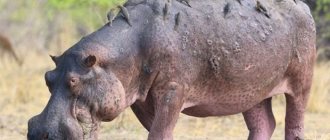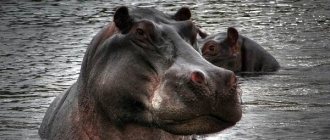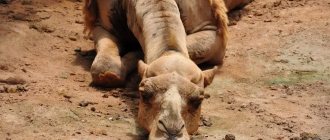The outwardly clumsy hippopotamus is dangerous for people - herbivores kill up to 3,000 people a year. Crocodiles, which inspire primitive horror, kill three times less people. Leos - 30 times. And the well-known heroes of horror films - sharks - are mentioned in this mournful list three hundred times less often. The hippopotamus, also known as the river horse, is one of the most dangerous animals in the world!
Hippopotamus: general characteristics
These animals belong to the class of artiodactyl herbivores, and represent a single genus in the hippopotamus family. Due to their enormous size, they are one of the three largest land mammals, second only to elephants in size.
Previously, hippos were considered close relatives of pigs, and there are indeed certain similarities between them. But when studying the structure of animals, their lifestyle and DNA genome, zoologists came to the conclusion that hippos have most in common with cetaceans, and they are an intermediate species between terrestrial and aquatic mammals.
The hippopotamus is a close relative of whales and dolphins
The size of hippopotamuses is simply impressive: they reach a height of more than 1.5 meters and weigh from 2.5 to 4 tons. Interestingly, the body weight of hippopotamuses increases throughout their life, and the older the animal, the more impressive its size and weight.
The hippopotamus family also includes dwarf (or Liberian) hippos. Compared to their larger fellow tribesmen, they are truly “tiny”, with a height of no more than 80 cm and a weight not exceeding 270 kg. And also, unlike their large relatives, pygmy hippos lead a solitary lifestyle, spend most of their time on land, and have a completely peaceful and calm disposition.
Hippos have a brownish-gray color, and in some places their skin has a pinkish or green tint. The skin of animals is very dense, in some parts of the body up to 4 cm thick, covered with small bumpy growths. But, since the skin of hippos is devoid of sweat and sebaceous glands, it is sensitive to sunlight and prone to drying out, so they are forced to spend the lion's share of their lives in water and take mud baths. But on the body of hippopotamuses there are special skin glands from which a red mucous secretion is secreted. These secretions are called “bloody sweat”, they absorb ultraviolet radiation and have disinfecting properties.
Another feature of African giants is their strong, powerful jaws. Hippos are capable of opening their mouths 180 degrees, and can easily bite a person or crocodile in half. The size of their sharp fangs is also striking, which grow throughout their lives and can reach a length of 65 cm.
On land, hippos are slow and clumsy, although they can run at speeds of 40 km per hour if necessary. But in their native water element they are agile and playful, they swim and dive well. By the way, hippos are the only terrestrial animal capable of making sounds while underwater.
In the wild, hippos live 35-40 years; in captivity, their life expectancy ranges from 50 to 60 years.
Elena
Ask a Question
Question to the expert
How long can a hippopotamus stay underwater?
These animals are capable of staying under water for 5 minutes. Before diving, the hippo takes in more air into its lungs and sinks to the bottom to take a nap. Then, the giant comes to the surface for a new portion of oxygen, and again lies at the bottom of the reservoir to continue his daytime sleep.
Big panda
Photo: Wikimedia Commons
These cute bears may have the word "big" in their name, but the only correct word to describe a newborn panda is miniature. The World Wildlife Fund notes that a giant panda cub is approximately 1/900th the size of its mother. Size is not the only difference between mother and baby. The giant panda is the most recognizable bear species in the world thanks to its black and white coat. During the first week of life, the panda cub is pink. Then, black spots begin to appear on the skin around the eyes, ears, shoulders and legs.
Natural habitat
Hippos inhabit only one continent - Africa, and even then they are found only in the eastern and southern parts of it. Previously, thick-skinned giants were found throughout the continent, were common in Algeria and Morocco, and in Egypt, populations of hippopotamuses lived in the waters of the Nile until the 20th century.
Hippos are native to Africa
Human activity in draining swamps and developing the natural pastures of hippos for farmland has led to a decline, and in some places, the complete disappearance of these animals. And centuries-old hunting has significantly reduced the once huge population of hippos, the situation especially worsened with the invention of firearms.
At the moment, the natural range of hippopotamuses is limited to the following countries:
- Mozambique;
- Kenya;
- Uganda;
- Tanzania;
- Zambia;
- Liberia;
- Malawi;
- Zimbabwe;
- South Africa (only in the Kruger National Park).
Hippos live in fresh water bodies, although sometimes they swim into salty river deltas. They prefer rivers and lakes with lush coastal vegetation, but they do not pay much attention to the purity of the water, and can even settle in a muddy swamp. But for hippos, the size of their territory is very important, because the larger and deeper the body of water, the less likely it is to dry out. Hippos are reluctant to leave their native places, and look for new water areas only if their river or lake dries up.
Carnivorous vegetarians
Despite the fact that hippos are considered herbivores, they gladly dilute their diet with meat, easily snacking on antelope, crocodile, and, on occasion, humans. Herds of hippopotamuses easily go to graze in fields close to reservoirs, causing irreparable damage, at the same time trampling or devouring farmers protecting their crops.
In 2000, on the Niger River, a herd of hippopotamuses terrorized the surrounding area, attacking boats, destroying fishing opportunities, killing people, livestock and ravaging rice fields. Numerous complaints about the whales' brutalized relatives did not help.
In 2014, an extremely aggressive hippopotamus attacked a boat with schoolchildren sailing to class. 12 children and one adult died. The Senegalese government has promised to provide local residents with motorized metal pirogues, nets and life jackets as support. Officially, hunting hippos is prohibited.
What do hippopotamuses eat?
Although these animals live in reservoirs, they do not like aquatic plants, so the basis of the hippopotamus’ diet is herbs and various greens. As soon as the sun sets, hippos come to land and spend the night hours eating succulent plant stems, young shoots of bushes and reeds. An adult hippopotamus requires at least 40 kg of food per day, but with an abundance of green food, it can eat up to 70 kg of grass.
Hippopotamus at the evening meal
Hippopotamuses have a very specific feeding method: they do not chew plants, but grab entire bunches of stems with their fleshy lips, after which they simply swallow them. By the way, hippos eat exclusively terrestrial parts of grasses; their wide muzzle is not adapted to digging up roots and plant tubers.
The hippopotamus menu sometimes includes meat. Surprisingly, these giants can attack antelopes and gazelles in the water, and happily feast on the caught herbivore. Hippos do not disdain carrion, and cases of infanticide have also been observed among them, when adult individuals (mainly males) kill and eat newborn cubs.
Ebola
Ebola virus disease (EVD) affects humans and some animal species. The virus was first recorded in 1976 in Zaire (now the Democratic Republic of the Congo, DR Congo), in a village on the banks of the Ebola River, which is why it received its name. It is believed that bats were originally carriers of the virus. It is transmitted to humans from wild animals and spreads from person to person through close contact through mucous membranes or breaks in the skin. The disease is manifested by fever, jaundice, hemorrhagic syndrome and renal failure. The incubation period varies from 2 to 21 days. During disease outbreaks, mortality rates reach 90%. Experts identify five varieties of the virus: Bundibugyo (BDBV), Zaire (EBOV), Sudan (SUDV), Thai Forest (TAFV), Reston (RESTV; affects only animals).
Outbreaks of the fever were recorded in the Democratic Republic of Congo in 1976, 1995 and 2007, in Sudan in 1976, in Uganda in 2000 and in the Republic of Congo in 2003. The epidemic claimed the greatest number of lives in 2013-2016, affecting Guinea, Sierra Leone and Liberia. Cases of the disease have also been recorded in Mali, Nigeria, Senegal, Spain, Great Britain, Italy and the United States. According to WHO, since the beginning of this epidemic, about 30 thousand people have become infected, and 11.3 thousand people have died. In 2018-2019, outbreaks of the epidemic occurred intermittently in the DR Congo (3.4 thousand cases, 2.3 thousand deaths).
Natural enemies of hippos
It is difficult to imagine that such huge and powerful animals could have enemies. Indeed, few predators consider hippos as potential prey, so the thick-skinned giants can feel relatively safe.
Few predators risk messing with a hippopotamus
In relative terms, because lions still run the risk of attacking adult hippos. And they attack them on land, where hippos are more vulnerable and clumsy. And considering that these formidable cats hunt in a pride, lions have a good chance of getting a tasty morsel in the form of a hippopotamus carcass for dinner. Predators often die in battles with giants, but still, their hunt is successful in most cases.
Well, baby hippos often become victims of crocodiles, the same lions and always hungry hyenas. Moreover, predatory animals attack weak young children, both in the water and on the shore.
Question to the expert
Do people hunt hippopotamus?
Yes, hippos have been hunted by humans since ancient times. Previously, they were killed for their strong, thick skins, from which shields and whips were made. And now hippos are hunted for their strong, sharp tusks, which are valued even more than ivory on the black market. And the native tribes of Africa eat hippopotamus meat, and in some restaurants it is served to tourists as a delicacy.
The sudden powerful blow that Paul felt behind him took him by surprise.
“I turned just in time to see Evans, who had been thrown from the kayak, flying through the air. His boat, with our tourists still in it, was thrown above the water, dangling on the back of a huge hippopotamus.”
Paul shouted to the remaining guides so that those who had the strength to swim to a cluster of stones that turned out to be nearby. It was at least a little safer there than in open water. The remaining guides began to rescue tourists, and Paul rushed towards Evans. He had already swam to his stunned friend and even managed to grab his hand. But as soon as their fingers crossed, Templer plunged into darkness. It was sudden, swift and deafening.
Reproduction
Polygamous. Hippopotamuses mate in water. The gestation period lasts 240 days, which is a very short period for such a large animal. Before giving birth, the female leaves the herd, and the baby is born in the water. A newborn hippopotamus is usually born alone and weighs from 25 to 50 kilograms.
relationships within the team
Individuals living near the equator can give birth throughout the year, but there may be birth peaks associated with precipitation. The surges occur at the beginning of the rainy season. Away from the equator, where precipitation is less, seasonal fertility prevails.
Breastfeeding lasts about a year. The cub remains with the mother even if a second child is born, but leaves before puberty. Sexual maturity occurs at 7.5 years for males and at 9 years for females.
AIDS
Acquired immunodeficiency syndrome (AIDS) is a disease that develops when infected with the human immunodeficiency virus (HIV). The virus attacks the immune system and weakens the body's defenses against infections and diseases. HIV can be transmitted through sexual contact, contaminated blood transfusions, the use of contaminated needles or sharps, and from mother to child during pregnancy, childbirth, and breastfeeding. AIDS can develop 2-15 years after infection. There is no cure for HIV infection. However, through treatment with antiretroviral drugs, the virus can be controlled, transmission can be prevented, and its destructive effects on the body can be reduced.
Some scientists believe that HIV spread from monkeys to humans as early as the 1920s. The first victim of this disease was presumably a man who died in the Congo in 1959 (doctors came to this conclusion after later analyzing his medical history). For the first time, symptoms of the disease characteristic of HIV infection were described in June 1981 in the USA. In 1983, researchers from the United States and France described a virus that can cause HIV/AIDS.
According to the Joint United Nations Program on HIV/AIDS, in 2022 there were about 37.9 million people living with HIV in the world, of which 1.7 million were children under the age of 15. The most unfavorable region is the countries of Eastern and Southern Africa, where about 20.6 million infected people live. The number of new cases of HIV infection has decreased by 40% compared to 1997, when this figure reached its peak, from 2.9 million to 1.7 million. In Russia from 1987, when the first case of the disease was detected, to June 30 In 2022, 1.38 million HIV infections were registered among citizens of the Russian Federation, of which 335 thousand 867 people died.
Herbivores or carnivores?
It is obvious that members of the family love grass growing on land most of all. Because of this, they are classified as herbivores. However, over the years, their teeth wear down, and they are no longer able to eat enough grass to fill themselves. And they begin to diversify the menu with meat so as not to starve. Moreover, scientists prove that even in younger years (and they live 40-45 years), not all of them disdain animal food. Most often their victims are antelopes and crocodiles. To catch such fast food, they often have to reach speeds of up to 50 km/h!
Plague
Plague (or plague disease) is an infectious disease, the causative agent of which is the bacterium plague bacillus (lat. Yersinia Pestis; discovered in 1894), found on small animals (rodents) and on the parasites that live on them - fleas. It is transmitted to humans through the bite of an infected flea, through direct contact with infected materials, or through airborne droplets from a sick person. The incubation period is 3-7 days, then typical flu symptoms develop: sudden fever, chills, headache and body aches, as well as weakness, nausea and vomiting. There are three forms of plague. In the bubonic form, the most common form, the plague bacillus attacks the lymph system. As a result, the lymph node becomes hard and a bubo appears on the body. In the late stage of the disease, the inflamed lymph nodes turn into festering wounds. In the septic form, the infection penetrates through cracks in the skin and enters directly into the blood. Pneumonic plague, the most severe and least common form of plague, is accompanied by damage to the respiratory system. If left untreated, the disease can lead to severe complications and death (mortality rate - 30%-60%). Antibiotic treatment and supportive care are effective in the fight against plague. If left untreated, the disease can quickly lead to death.
The first information about a disease with similar symptoms dates back to the times of Ancient Rome. However, it is believed that it was widespread in an earlier period in the territory of modern Libya, Syria and Egypt. In the past, plague has caused widespread pandemics. In the XIV century. One form of plague, better known as the Black Death, according to some estimates, killed 50 million people. According to the World Health Organization (WHO), in 2010-2015, 3,248 cases of plague of various forms were registered, and 584 people died from the disease.
Coronaviruses
Coronaviruses are types of viruses belonging to the Coronavirinae subfamily of the Coronaviridae family (order Nidovirales). First discovered in the 1960s, they cause gastrointestinal and respiratory infections in both humans and animals. There are 39 coronaviruses, including the Severe Acute Respiratory Syndrome and Middle East Respiratory Syndrome viruses.
Severe acute respiratory syndrome (SARS), also known as atypical pneumonia, is an acute infectious respiratory disease that is characterized by rapid development and a mortality rate of about 10%. The incubation period (the interval between infection and the onset of symptoms) is usually up to 10 days. The disease begins with an increase in temperature (more than 38 degrees Celsius), the appearance of fever, chills, headache and muscle pain. After 3-7 days, the deterioration phase of the respiratory system begins. The disease spreads through airborne droplets and household contact.
The SARS outbreak was first reported in November 2002 in the southern Chinese province of Guangdong. Subsequently, numerous cases of the disease were recorded in China, Vietnam, New Zealand, Indonesia, Thailand and the Philippines. In addition to Asian countries, SARS has been reported in North America and Europe. In Russia, only one case of the disease was recorded (the patient was cured). According to WHO, during the epidemic in 2002-2003, the total number of cases in 37 countries of the world reached 8 thousand 437 people, of which more than 800 died.
Middle East respiratory syndrome (MERS) was identified in 2012 in Saudi Arabia, from where it spread to other countries in the Middle East. According to one of the WHO versions, camels were carriers of the virus. Manifestations of MERS are similar to the common flu: fever, cough, difficulty breathing, general malaise, diarrhea. The incubation period is 7-14 days. It is rarely transmitted to children (according to statistics, children under 14 years old make up 3% of all cases). Mortality rate is 35%-40%. In 2012-2015, cases of the disease were recorded in more than 20 countries, including the UK, Germany, China and the USA. In total, since September 2012, according to WHO, more than 1.3 thousand laboratory-confirmed cases of infection have been recorded worldwide, including more than 460 deaths. Treatment is used using blood plasma from patients who have successfully survived coronavirus infection.
By the way, about teeth
A hippopotamus has not 8 or even 12 teeth, as it might seem, but more than a human - as many as 36. The canines and incisors have no roots and continue to grow throughout their lives, rubbing against each other and bending inward. Their weight can reach 3 kg, and their length can be up to 1 meter (usually 55-65cm). If an animal loses one of its upper canines, the lower one begins to grow uncontrollably and can reach abnormal sizes, making feeding very difficult. The impression that a hippopotamus' teeth are blunt is deceptive, like everything else about this animal. They are sharp on the outside and are never used for chewing food. This is, first of all, a weapon, and secondly, a tool for digging hard salty soils, for example, in salt licks.
These tusks are valued more highly than elephant tusks. Before porcelain dentures were invented, dentists used implants from the fangs of this animal. They consist entirely of bone tissue, and yellowness is present only in the outer layer, so these false teeth do not turn yellow over time.
Sharp spears in a huge mouth
In fact, the yawns of slow bumpkins, which touches many, are a threat, a demonstration of the size of their teeth to a possible enemy. After such a demonstration, a rapid dash towards the opponent may follow, bringing painful death.
The fangs of a river horse can reach a size of 1 meter or more, but, as a rule, they vary between 50–65 cm, grinding against each other, at the same time sharpening, turning into real spears. The fangs can weigh up to 3 kg each. By their size and wear, one can determine the approximate age of hippopotamuses, since their teeth grow throughout their lives .
Read also: In the North Pacific Ocean there is a fish with a transparent head
The bone of a dangerous animal is no less valuable than ivory, especially since it does not turn yellow over time and is more durable. Before treatment, the teeth are first soaked in acid to dissolve the incredibly strong enamel, otherwise the material will simply be impossible to work with.
№4
They exhibit sexual dimorphism. Males are always larger than females. The average body weight of a male varies around 1500 kg. Female representatives have a body weight of around 1200 kg.
It is worth noting that males can have greater mass. For example, there are individuals whose body weight is in the region of 2000-2600 kg.
Top 10 most dangerous human diseases
About 150,000 people die every day around the world. 60% of them - about 100,000 people - die from diseases, including age-related ones. The most common diseases leading to death are stroke, heart attack and obstructive pulmonary disease. Basically, they appear due to poor lifestyle, age-related changes, lack of prevention and proper treatment.
Below are statistics on annual deaths from the most common diseases according to the World Health Organization:
Scientists and doctors have not yet figured out how to completely avoid or completely cure most of these diseases, so every person from an early age should independently monitor their health, regularly undergo preventive examinations and be observed by doctors. Despite their widespread distribution, these diseases cannot be called the most dangerous. Infectious diseases have always caused the greatest harm to humanity. Their main danger is the possibility of rapid spread of infection, which causes epidemics and pandemics. Even today, scientists cannot immediately invent a vaccine after the emergence of a new virus to cure the sick and prevent the spread of infection throughout the world. Illustrative examples of recent decades have been widely covered in the media - Ebola fever, bird and swine flu. In the past, the situation was much more dire:
- the plague wiped out half of Europe;
- during the war with Napoleon, more people died from typhus than from wounds;
- Spanish flu affected 40% of the population of Spain and 550 million people in the world, of which 100 million died;
- Black smallpox quickly spread throughout the world and did not spare even kings.
Top articles : Harrier: rare hare hound native to England
The danger of infection lies in the wide variability of transmission:
- exchange of biological fluids;
- blood poisoning;
- airborne droplets;
- through mucous membranes;
- through handshakes and objects.
Throughout the history of the planet, the most dangerous diseases in the world for humans include:
Black pox is a disease of poor men and kings. Plague is the most dangerous disease in Europe. Malaria - from insects to people. Cholera is one of the most dangerous infections
Rabies - it is important to get vaccinated on time. AIDS is the most common disease
The Spanish flu is the largest influenza epidemic. Tuberculosis is still incurable. Polio is the most terrible childhood disease. Typhus is a military disease.
Everything is like people
After the family, after several weeks of isolation, returns to the herd with a new addition, the young animals unite and sometimes begin to frolic beyond measure. Games can escalate into a fight, as a result of which the offended young hippopotamus begins to scream loudly and call for his mother. She immediately runs to the cry and, despite the young age of the offender, attacks him. It’s his turn to call his mother for help, and the matter often ends in a real massacre of the females.
Smallpox
Smallpox is caused by the variola virus (lat. Variola). It is transmitted by airborne droplets, as well as through objects with which an infected person has been in contact. The incubation period is 7-17 days. The disease begins with a sharp increase in temperature, headache, and often nausea and vomiting. After 2-3 days, the temperature subsides, a nodular-vesicular rash appears on the skin and mucous membranes, leaving behind scars (pockmarks). In 30% of cases there is a fatal outcome; in rare forms (confluent, hemorrhagic, purpuric) the mortality rate reaches 70% or higher.
Until recently, it was believed that smallpox appeared in Africa or Asia in the 4th millennium BC. e. However, today scientists suggest that the human virus is close to the camelpox virus and passed to humans in the Middle East region at the beginning of our era. The smallpox epidemic first swept across China in the 4th century, and in the 6th century. hit Korea. In the 8th century the disease was brought to Europe (in the 17th-18th centuries, epidemics covered almost the entire population of Europe, more than 1.5 million people died from this disease every year; in Russia, this disease reached its highest prevalence in the 18th century). By the beginning of the 16th century. These are the first mentions of smallpox in America, where it could have been brought by the Spanish conquerors. At the end of the 18th century. smallpox was introduced to Australia.
It was possible to cope with the disease thanks to the WHO global vaccination program implemented since the second half of the 1960s. The last human case of smallpox was recorded on October 26, 1977 in Somalia. Victory over the disease was officially announced in 1980. Only two laboratories have the right to store the virus and conduct research: the Russian State Scientific Center for Virology and Biotechnology “Vector” (Koltsovo village, Novosibirsk region) and the American Center for Disease Control and Prevention (Atlanta, Georgia).








